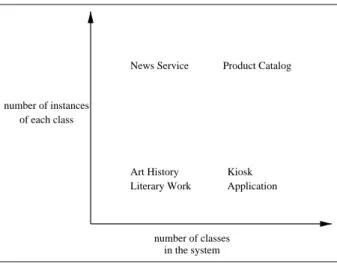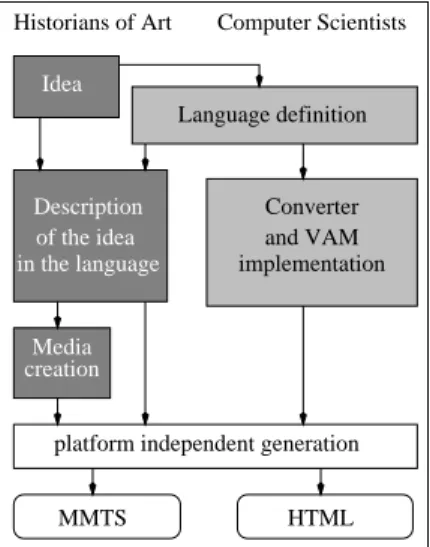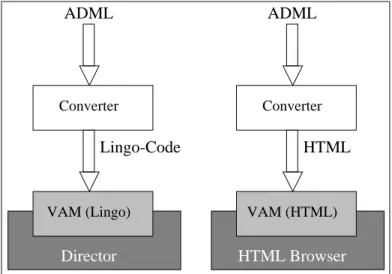Teaching the History of Arts
Klaus Alfert
Ernst-Erich Doberkat
CorinaKopka
Chairfor Software-Technology
University of Dortmund
Germany
falfert|doberkat|kopkag@ls10 .cs .uni -dor tmun d.d e
Phone: +49+231-755-2781
Fax: +49+231-755-2061
Abstract
Multimediaproductiondisplaystwofaces: amultimediaproductistheresultofpro-
grammingaswellasofpublishing. Constructingamultimediaenvironmentforteachinga
courseinthehistoryofartssuggeststhatrequirementselicitationhasmanyfacetsandis
centraltosuccess,hencehastobedeltwithinaparticularlycarefulway,themoresosince
wewantedthearthistoriansworkinginaspecicandcustomtailoredenvironment. The
problemwastechnicallyresolvedbyconstructingadedicatedmarkuplanguagebasedon
XML.Wediscusstheprocessofrequirementselicitationthatledtothemarkuplanguage
and showhowthis isused asacornerstonein the developmentofsuchan experimental
environment.
Keywords and Phrases: Multimediaenvironment,XML, DTD,AltenbergerDom
Markup Language, multimedia in teaching the history of arts, requirementselicitation,
translationandinterpretation.
TheworkreportedherehasbeenpartiallyfundedbyUniversitatsverbundMultimediaNordrhein-Westfalen
1 Introduction
Teaching the history of art does not yet fully capitalize on the possibilitiesoered by mul-
timedia. This is surprising since the history of art is nourished by visual representations.
On the other hand, scholarly ideas are presented quite similarly to teaching philosophy, so
on second thought the lackof multimediateaching material may be attributed to not(yet)
having a sturdy bridge between ideas and pictures. Of course, teachers in art history have
longmadeuseofvisualaids,usuallydisplayingslidesorpictures. Thiskindofpresentingthe
necessaryvisualinformationisnotfullysatisfactory to eitherstudentsor instructors:
slides and pictures in books are quite static, some of the things to be presented are
dynamic, hencechangehasto berelatedexplicitely. Thisisachieved usuallythrougha
wellchosen sequence ofpictures, conveyingdynamics,albeitonlyto a limitedextent,
textual andvisualinformationislinkedconventionallythroughnarration;studentsnd
it dicultreestablishing links when rehearsing the lecture: pictures and explanations
(or explications)are gone, taking notes is noteasy, inparticular when the lecture hall
is dark,
backgroundinformationissometimeneeded,butnotalwayatthengertipsofinstruc-
tors orstudentswhen a topic isconventionally presented.
A multimedia presentation links text and pictures lively, eectively and in a customizable
manner,easingtheburdenofestablishinganmentalconnectionbetweentextualandpictorial
representation. It mayoer anexplanation fortheevolution of phenomena,hence capturing
dynamics,anditmayprovideamplebackgroundinformationthroughhyperlinks. Thisisour
vision.
Certainlywe do notwant to leave the impressionthat the conventional mode of teaching is
obsolete,badorplainlyunattractive. Whatwearepleading|andworking|forisutilizing
multimediaas adevice forcomplementing and embellishingthe traditionalapproach.
WedecidedenteringacooperationwiththeChairforArchitecturalHistoryatouruniversity.
This cooperation aims at the construction of a multimedia representation of the Altenberg
Cathedral. The cathedral isawellknownand importantGothic church intheRhineland. It
entertains features that are of interest to future architects aswellas civil engineers. These
studentshave totakeacourseinarchitectural historyinwhichthecathedral featurespromi-
nently.
Fromthebeginningweunderstoodthatbothpartieswouldbenetfromthisprojectinrather
specicways. Thearthistorianswouldobtainamultimedialcomplement to theirtextbooks,
andtheywouldconstructavehicleforteachingtheirstudentsthein-depthworkwiththenew
electronic tools. We as software engineers would help in constructing this vehicle, gaining
insight into an intellectually very attractive eld together with obtaining a possibility of
learningaboutthe architecture of multimediasystems. Most important, we ndit exciting
to gain some experience in requirements elicitation in a eld that has not seen too many
computerscientists' footsteps.
The present paper is intended to report on this joint project from the software engineer's
perspective. We want to relate where we encountered principal diculties, how we tried
to overcome them, and what we learned from these experiences. In particular we draw the
reader's attention to problems of requirements elicitation that emerge in a context where
scholars and engineers cooperate. Finally we report on a solution forthe construction of a
multimediaenvironment,and we indicatewherewe endeavourfuture work.
2 The Perspective
Introducingcomputer-based traininginto an art historycourse is byno means a trivialun-
dertaking. Usually the infrastructure is not comparable to a setting in which engineering
courses aretaught, butthe missing infrastructure may easilybe overcome. But the reasons
forthenon-trivialityliedeeper.
Considerthese observationswe made when cooperating withthegroup fromart history:
traditionally there is enough pictorial material to be taught from, including graphics
usede.g.toanalyzeagivenarchitecturalsituation. Thismaterial,however,issometimes
not particularlysuited forbeing usedina multimediaenvironment.
This is so since it is organized according to principles which are introduced to serve
the human user, but not to be applied with a computer; the informal organizational
schemesaredicult| ifnotimpossible| tomap to amaintainable databasedesign.
wefounditdiculttotalktoeachother|thewayarthistoriansorganizetheirteaching
is understandablydierentfrom theway computerscientists do,and viceversa.
Hence requirement elicitation had to be preceded by a phase of learning of mutual
understanding.
thenecessityof ourdoingpreparatorytechnicalwork wasnotalways immediatetoour
art historians.
Hence there was an incentive to have quite early something that could be presented
rather inpreference to workingon seeminglyintangible specications.
We resolved these problems in ourcooperation byattempting to agree on the followingap-
proach:
1. thetargetplatformisfactoredout,sothatworkcanbedoneindependentofaparticular
hardwareorsoftwareplatform,
2. requirements are going to be xed and described in a sequence of scenarios, which in
turn willbe translatedinto arepresentable form,
3. weintendto construct adevelopment environmentthatshouldbeuserfriendlyenough
so that non-computer scientists will be able to work with it. The environment will
eventuallybe process-based.
3 Related Work
TheZ
Y
X model[BK99]isused forsemantic modelingof multimediacontent. TheZ
Y X mul-
timediadocument modelhasbeendevelopedinthecontext of adatabase-driven multimedia
informationsystem. Themodeldescribesmultimediadocumentsbasedon atree. Thenodes
ofthetreearepresentationelementslikevideos,images andtext oroperatorelementsallow-
ing temporal synchronization, denition of interaction, spatial and audible layouting. The
modeloerssupportinstructuringthe presentationdocumentand combiningmediaobjects
at layout design level and do not support a didactical design and instantiation phase with
logicalelements,whichshouldprecedesynchronizationandlayoutingofmediainthesoftware
development process ofa multimediateaching system(MMTS).
The process model for the development of multimedia applications in [DEM +
99 ] is based
on an analysis and a design phase using the programming model of an authoring system
(Director)and onimplementingwiththisspecicauthoringsystem. First,ananalysismodel
oftheapplicationisconstructedandaprogrammingmodeloftheauthoringsystemisderived.
Thentherelationbetweenthesemodelsisanalyzed. Aninstanceapplicationmodelismapped
to an authoring system model using this relation. This approach employs an analysis and
designphase trying to llthegap betweenthe analysis modeland implementation usingan
authoring system. It was developed in parallel to our approach and is rather closely tied
to the programmingmodel of an authoring system. It is abstract in the sense that it does
notcater for a particular application, and it is quitespecic inthe use of theprogramming
tools. Incontrasttothismodel,weemphasizetheroleofdomainanalysisintheconstruction
of thelanguage we use, and of supportingtools maintaininga platformindependent way of
representation.
TheRelationshipManagementMethodology(RMM)[ISB95 ],HypertextDesignModel(HDM)
[GPS93 ]and Object-OrientedHypermediaDesign Model(OOHDM) [SR95] areusedforhy-
permedia or multimedia applications in those areas that display a high degree of domain
structure.
Nanardetal.discussin[FNN96]theirSGML-basedauthoringsystemPageJockeyandpresent
theprocessbetweensketches, templates,andnalreleasesofmultimediaapplicationsrealized
indierentSGMLlanguages. Thetechnicalfocusliesontheabstractmodelsandthemapping
betweenthem,themethodicalon thedesignprocessof visualdesign. Theyareaimingon an
earlyvisualfeedbackofapplication derivedautomaticallyfrom sketches andtemplates.
Morris and Finkelstein [MF92] are discussing a method for constructing a hypertext in the
eld of history of art, later generalized as a design process integrating the visual designers
inan explicitway [MF96, ]. It is not clear inhow far their method could be supported by
adevelopment environment,because thetransformationprocess of mediaformallydescribed
inthemodelis notfullyoperational.
4 The Formal Structure of Multimedia Applications
In the methodologies[ISB95 , GPS93 , SR95 ] quoted above the structure of the presentation
is derived from the structure of the application's domain or content. This is just one point
in a spectrum: the pronounced structuring of a domain induces a formal system structure
thatcan behandledwithcomparableease. Figure1indicatesthatthereareothersituations,
classiedagainst numberof classes vs. number of objects drawn from each class. Generally
speaking, many classes in a system arise whenever the application domain admits a model
with a highly perceivable formal structure, many instances of a class are generated when a
high degree of similarity has to be captured, see e.g. [Jac92, II.7] or [GHJV95 , p. 107], in
particularthediscussionleadingtotheFactorypattern. NowconsiderFigure1. Itillustrates
typicalhypermediaandmultimediaapplicationsclassiedinrelationto thenumberofclasses
andthenumberof instancesofeach class representedby thetwo axes.
Art History Literary Work
Kiosk Application News Service
number of classes in the system of each class
number of instances
Product Catalog
Figure1: The kindsof hypermediaandmultimediaapplications
The domain presented in a product catalog [SKT +
97 ] is characterized by a large number
of product types (classes) and a large number of products for each product type (objects).
Front-ends of databases are quite similar. The so called point of information (POI) as a
typical application of kiosk systems has to present many dierent elds (i.e. the classes in
thisdomain) of an enterprise, a city, a railway station, a museum, etc., but may have just
one instanceforeach eldor at mostavery smallnumberofinstances.
On the other hand there are applications with a small number of classes in the domain
represented. A News service presented by a television channel or a news site presented by
an enterprise on the Internet is a type of application that is adequately represented by just
one class. This kind of application is characterized by the restriction of constructing only
instancesofthisclass.
Our domainin thisprojectis architectural history. Thisdomain has alow formalstructure
witha smallnumberof classesand a small number of instances, often uniqueobjects. The
complexity of the domain is spread out over a few classes and these classes will be very
complex. So the usefulness of the mentioned methods for our domain (art history) is low,
because these methods base on domain modelling with a supposed regular structure of the
domain.
Asmallnumberofclassesand a smallnumberof instancesinthesystem containseach kind
of application presenting artistic work as content, e.g. literary work or art history. These
domains, although intrinsically highly structured, present hardly any handle of structuring
them formally according to our needs. Thustheir presentation in a multimediaapplication
doesnotdependontheformalcontentstructure(forexample,structuringnovelsintochapters
for Electronic Books does usually no justice to the artistic quality). A structuring facility
for presenting architectural history could e.g. be a presentation form like a Guided Tour.
Althoughthe construction of such a tour is not theintent of our project, we adopt some of
theideas,aswillbe seenlater.
5 Our Approach to the Development Process of a Multimedia
Teaching System
Multimediaapplicationsarelargeand complexsoftwaresystems,which shouldbe developed
usingsoftware engineering methods. Existing authoring systems like Director, Toolbookor
Authorware support only the programming phase of the software process, similar to inte-
gratedenvironmentslikeVisualC++,Delphi,etc. Theydonotsupportmodelingduringthe
analysisand designphase. But modelingshouldprecedeimplementationinthe development
ofsoftwaresystems.
The development of a multimediaapplication isdierent from thedevelopment of software.
Wewanttodevelopamultimediapresentation(MMP)whichturnsoutto bebothaprogram
and adocument | thisis an importantobservation for thedevelopment that follows. This
existenceofdierentviewsisacknowledgedbythepartiesinvolved: thearthistoriansperceive
the presentation as a document with a course structure and media content. The software
engineerssee thepresentation asa program. By thisdualityof multimediapresentationsas
programsandasdocumentstheconstructionofaMMPnecessarilyintertwinesmethodsfrom
software construction andfrom publishing.
FurthermorewehadtodevelopourMMPasamultimediateachingsystem(MMTS).Forthis
kindof applicationthepresentationstructuredependsalso heavilyonthedidacticalconcept
and isin thisrespectquite independent of thecontent and its structure. Therefore we need
anapproach supportingintegration betweensoftwaredevelopment, publishingand teaching.
Itis thisapproach that willbe presentedhere.
Since markup languagesrely on a formal syntax and on the incorporationof narrative text,
they are ideally suited for our project once they permit enough exibility for processing
multimediadocuments. The class of languages suited to our needs is currentlyrepresented
by the XML approach [BPSM98 ], XML instances (or languages) being markup languages
similartoSGMLinstances,HyTime[NKN91]orHTML.Theselanguagesarealldenedbya
document typedescription(DTD).Hencea particularinstance ofXML isessentiallydened
by a DTD. We felt that the conversion of our requirements to a DTD would be the most
appropriate way of dealing with the restrictions imposed on us. Documents written in this
specicationlanguageareconverted into anexecutableprogram interpretedbyan authoring
system,theMacromedia Director.
Thus,ourapproachisdividedinto twoseparateparts. Therstpartdealswiththedenition
of a DTD suitable for our MMTS. The second part makes use of this DTD for writing
documentsand forbuildingtheMMTSitself.
TheDTD-DenitionStep. Thisstepissubdividedintotwosub-steps. First,weestablish
ananalysisphaseaimingatthestructure,thelayoutandthecaptureofthedidacticalconcept
of theMMTS. This phase is mostly driven bythe art historiansconsulted by the computer
scientists to ensure the technical feasibility of their ideas. The second sub-step formalizes
the results of the analysis as an DTD which we call Altenberger Dom Markup Language
(henceforth abbreviated by ADML; the Altenberg Cathedral is the only church we know of
that has a programming language named after itself). This is the work of the computer
scientists consulted by the art historiansto ensure that the formalization is a valid one. In
summary, the rst part requires and constitutes an extensive dialog between art historians
and computer scientists resulting in layout, structure and didactic concepts as wellas their
captureinaDTD.
SplittingtheGroups. Thesecondpartsplitsthetwodevelopergroups. Thearthistorians
writedocumentsinADML, formallyinstancesoftheADML-DTD, create mediaobjects and
combine them into scenes. This is the publishingstep. The computer scientists realize the
technical part of the MMTS and build a converter for the transformation of the ADML
documentsinto anexecutable multimediapresentation.
The approach to thedevelopment process of a multimedialearningsystem intheAltenberg
CathedralProject isdiscussed inthefollowingsectionsand issketchedinFigure 2.
in the language Description of the idea
Computer Scientists
Converter and VAM implementation Historians of Art
Idea
Language definition
Media creation
platform independent generation
HTML MMTS
Figure2: The approach taken intheAltenbergCathedral Project.
6 Steps towards a DTD-Denition
6.1 The Analysis Step
First the art historians have to establish a suitable presentation for teaching the Gothic
architecture. Starting witha vague idea of thelayout the logicalelements and the relations
betweenthemare identied. The descriptionofa sequenceof scenariosresultsinidentifying
dierent types of scenes. Scenes are the building blocks for the presentation. They were
originallyperceived as at, butturned out laterto be structured into topics and subtopics,
thusconstitutingahierarchicalorder. Topicsand subtopicscombinemediaobjects, textwith
hypertext facility being one of them. On top of this a navigation scene serving as a shell
yields access to the topics, to a library and a glossary. This navigation scene is intended to
support inductive learning starting from a special visual setting and leading to the general
situation explainingarchitectural aspects. The scene is realized by Quicktime VR [App97].
It centers around a visualrepresentationofthe Cathedral'sinteriorand exterior,identifying
spotsof intense pedagogical interest.
Tackling the problem in this phase of the project consisted in ordering the little chaos in
our minds, identifying the important logical elements of the presentation, assemblingthese
elementsin apresentation world and structuringthisworld.
6.2 The Model Creation Step
This stepmaps thepresentationstructureand elements oftheanalysis processinto aformal
representationmodelusingADMLasa specicationlanguage.
Each logicalelement is mapped into linguistic constructsof ouremananting language. This
applies particularly to the dierent scene types of the presentation world. Eventually, the
set of all these constructs constitutes the core of (the DTD of) ADML. This approach was
chosen for two reasons: First, software engineers need formal structures for working in the
developmentprocess. Second,arthistoriansmustworkwithADMLdocuments,becausethey
havetoconstructthepresentationatleastbyprovidingitscontent. Thelanguageconstructed
inthismannerallows constructingdocumentsat theinstancelevel. Thereal publishingstep
is describedinthe nextsection.
Summarizing, this phase of the project consists of mapping the art historians' presentation
world to an adequateformal world,whichinturn isneeded forthemultimediadevelopment
process.
7 Realization and Instantiation Step
The art historians write their educational material, create media objects such as images,
videos, animations, audio les, etc., and combine them in ADML documents. Didactical
conceptsusuallycannotbeformalized,exceptforasmallpartconcerningthestructureofthe
presentation. The formalized structureshapesthespace forthediscourse writtenbytheart
historians. Each ADML document is essentially an instance of the structure dened in the
DTD and thusavehicle forimplementingthedidactical ideas.
There exist in fact some similarities between ADML documents and objects in a program
whichareinstancesofclassesthatareinturnsimilartotheDTD.Incontrasttoprogramming
languages, the semanticsof ADML instances arenot foundinthe formally dened part but
rather are hiddenin the discourse written in natural language. Also the class model itself,
i.e.theDTD,isnotuseddirectly bytheauthors. AseachdocumentisaninstanceofADML,
the authors always operate directly on these instances ofthe model. The model denes and
providessomekindofframefortheirworkbyhelpingstructuringtheirthoughts. Inallother
aspects themodelsremainspassive. Any modications of themodel is to be undertaken by
the computerscientists.
This is a substantial dierence compared to classical software engineering and displays a
prominentexampleforthedocumentaspect ofmultimediaapplications. Inclassicalsoftware
engineering instances described in specicationparts of program systems are only used and
constructed by the end user at runtime, but not at development time. Programming may
be seenas arenement ofmodels,thusconstitutingincreasinglydetailedlevels of modeling.
But programming abstracts always from the objects used and deals only with classes (or
proceduresand functions), never withobjects (or procedure calls), which are phenomena of
program realization. Consideringtheother handthescenario suggested here,suchinstances
of models constructed during development are not modied by the users of the multimedia


